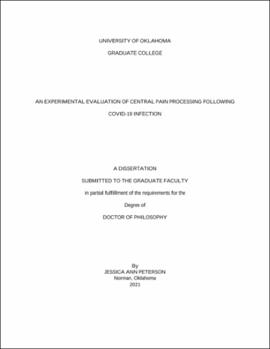| dc.contributor.advisor | Black, Christopher | |
| dc.contributor.author | Peterson, Jessica | |
| dc.date.accessioned | 2021-08-12T17:58:26Z | |
| dc.date.available | 2021-08-12T17:58:26Z | |
| dc.date.issued | 2021-08-05 | |
| dc.identifier.uri | https://hdl.handle.net/11244/330715 | |
| dc.description.abstract | Neurological symptoms, including pain, have been increasingly recognized as an area of concern in symptomatic patients of COVID-19. COVID-19 initiates an inflammatory response that can sensitize and activate nociceptors leading to painful symptoms. Localized and systemic inflammation has been suggested to play a role in the impaired pain modulation. Dysfunction of endogenous pain-modulatory mechanisms such as conditioned pain modulation (CPM) and exercise-induced hypoalgesia (EIH) have been found across a host of chronic pain conditions. It is unknown whether the COVID-19 virus has had an impact on pain sensitivity and pain modulation. PURPOSE: The purpose of this study was to examine and compare pressure pain sensitivity and pain modulatory function in individuals who have been previously exposed to COVID-19, both symptomatically and asymptomatically, to a control group who have not been exposed to the virus. METHODS: Pressure pain thresholds (PPT) of 59 participants were assessed in the vastus lateralis (VL) and brachioradialis (BR) using a pressure algometer on the dominant side of the body before and after submersion of their feet in an ice bath (2oC) for 1min and an isometric knee extension, time to failure task based off of 25% of maximal contraction. The difference between post and pre measures was defined CPM response (ice bath) and EIH response (exercise condition). RESULTS: PPT’s were not different between groups when normalized to lean body mass. CPM response was attenuated both locally and remotely in individuals who have had symptomatic COVID-19 compared to asymptomatic COVID-19 and control group. No differences were found in EIH response in individuals who have been exposed to COVID-19 and those who have not. CONCLUSION: CPM was impaired in individuals who had symptomatic COVID-19 and there were no differences found in individuals who had symptomatic COVID-19 up to 6 months ago and 6 to 12 months ago. No differences between groups were found in pressure pain sensitivity when normalized to lean mass, and no differences between groups were found in EIH response. COVID-19 exposure may have a long term impact on pain modulation, placing individuals who have had COVID-19 at risk increase for chronic | en_US |
| dc.language | en_US | en_US |
| dc.rights | Attribution-ShareAlike 4.0 International | * |
| dc.rights.uri | https://creativecommons.org/licenses/by-sa/4.0/ | * |
| dc.subject | COVID-19, Pain Modulation, Exercise Induced Hypoalgesia, Conditioned Pain Modulation. | en_US |
| dc.title | An experimental evaluation of central pain processing following COVID-19 infection | en_US |
| dc.contributor.committeeMember | Larson, Rebecca | |
| dc.contributor.committeeMember | Bemben, Michael | |
| dc.contributor.committeeMember | Pereira, Hugo | |
| dc.contributor.committeeMember | Crowson, Howard Michael | |
| dc.date.manuscript | 2021-07-22 | |
| dc.thesis.degree | Ph.D. | en_US |
| ou.group | College of Arts and Sciences::Department of Health and Exercise Science | en_US |
| shareok.orcid | https://orcid.org/0000-0002-5791-6883 | en_US |

